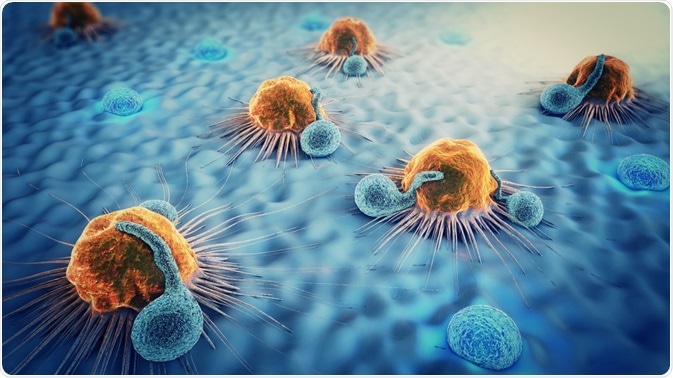Stimulators of interferon genes (STING) are cytosolic sensors associated with the endoplasmic reticulum that respond to the presence of dsDNA in the cytosol, usually indicative of an invading pathogen or self-leaked DNA from damaging events.
 Image Credit: Christoph Burgstedt/Shutterstock.com
Image Credit: Christoph Burgstedt/Shutterstock.com
Cytoplasmic DNA is firstly bound with the cyclic GMP-AMP synthase (cGAS) enzyme, which is activated to produce cyclic guanosine monophosphate-adenosine (cGAMP), acting as a second messenger by binding to STING with high potency.
Upon binding STING then travels to the endoplasmic-reticulum-Golgi intermediate compartment and induces the upregulation of various cytokines, including type I interferon. It is known that the kinase TBK1 is recruited, and is otherwise involved in innate antiviral immunity in addition to regulation of apoptosis and proliferation, and that interferon-inducing transcription factor IRF3 is activated, though the complete role and mechanism of STING are yet to be elucidated.
STING signaling
The cGAS-STING-TBK1 response is well documented as a major signaling pathway in the animal kingdom, and aberrant signaling has been associated with a number of conditions such as a compromised immune system, autoinflammation, and cancer.
Cancers effectively evade immune capture, and major research efforts have been focused on the restoration of tumor immuno-surveillance by promoting the STING pathway using agonist drugs.
Tumors with an intact pre-existing T-cell mediated immunity that is then deactivated by the dysregulated processes of the cancer genome are known as “hot” tumors, and these often respond well to small molecule drug inhibitors that regulate the immune response by inhibiting checkpoint molecules that suppress immune function expression.
Tumors with little to no chemokine expression or T-cell infiltration (“cold” tumors”) usually respond poorly, leading researchers to attempt strategies that better stimulate the immune response in these cells, turning them “hot”. These molecules are STING agonists, assisting in promoting the function of the STING pathway and reestablishing immune function, and have been the major focus of drug development related to this immune response.
STING agonist: mechanism of action
STING inhibition
More recently STING antagonists have entered the spotlight as immune suppressors for a variety of applications, for example, excessive STING signaling has been linked to a range of chronic but rare genetic conditions and diseases such as Parkinson’s and some types of lupus. Those suffering from many autoimmune diseases would benefit from STING antagonists, and they may prove a better solution than direct interferon inhibitors that often prove ineffective in clinical trials.
cGAMP is considered a STING agonist, binding with the protein to induce a transition from the open to closed conformations upon activation. One focus of the design of STING antagonists, therefore, is the stabilization of the open form to prevent activation. This is in contrast to a potential mechanism of STING agonists, which aim to stabilize the closed conformation.
Several STING inhibitors have been developed and synthesized based on crystallographic and in silico studies of the binding pocket of STING, and further modified to improve bioavailability and drug-likeness. In vivo and in vitro studies have revealed the effectiveness of such drugs, consistently and strongly inhibiting the mRNA expression of interferon, tumor necrosis factor, and other cytokines.
Inhibitors of the other aspects of the cGAS-STING-TBK1 response are also under investigation, with both cGAS and TBK1 inhibitors each proving effective in lowering the expression of pro-inflammatory cytokines, in some studies resulting in suppressed tumor proliferation and development. Other clinical applications of TBK1 inhibitors include combating low-level chronic inflammation associated with obesity and type 2 diabetes, with some positive early results.
Our understanding and ability to regulate and modify the cGAS-STING-TBK1 pathway is in the early stages, and knowledge of the precise mechanisms that can be manipulated to enhance or suppress the immune response by this route is far from complete.
It is thought that inhibiting an immune signaling pathway such as STING may be easier to accomplish than stimulating one, in terms of both ease of drug discovery and assurance of safety profile, where stimulatory mechanisms are more likely to induce cascading events and potentially produce a cytokine storm.
STING agonists have been investigated as potential COVID-19 therapeutics, inducing interferon production to stimulate an anti-viral response with some promising results in SARS-CoV-2 suppression.
Conversely, STING antagonists have also been investigated for applications in suppressing the cytokine storm associated with the symptoms of severe COVID-19, where dysregulated interferon production is frequently observed. SARS-CoV-2 has been demonstrated to induce this pro-inflammatory response via the STING pathway, and while in the early stages, these therapeutics could play a key role in preventing COVID-19 related deaths.
Further Reading